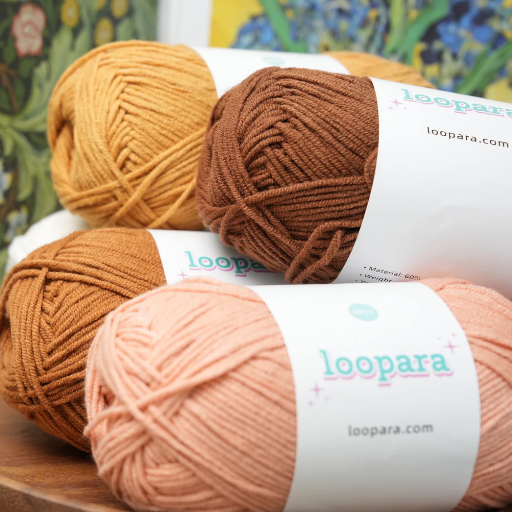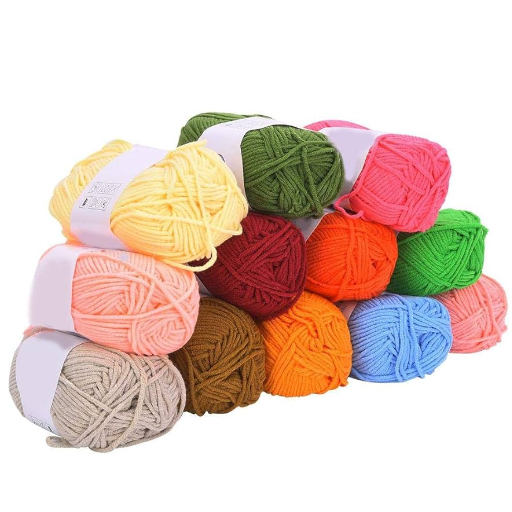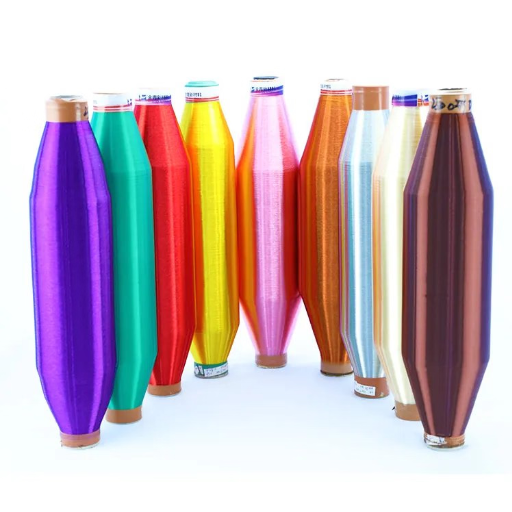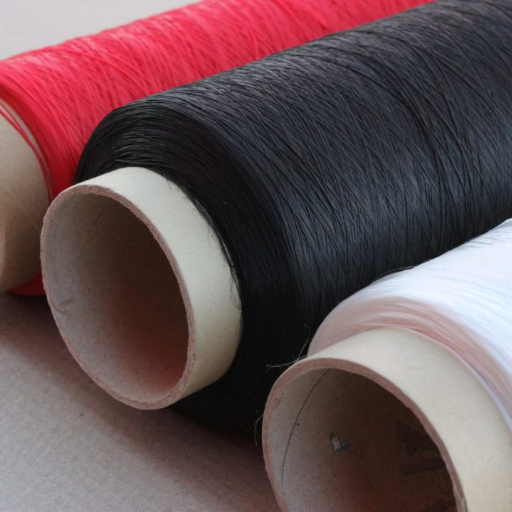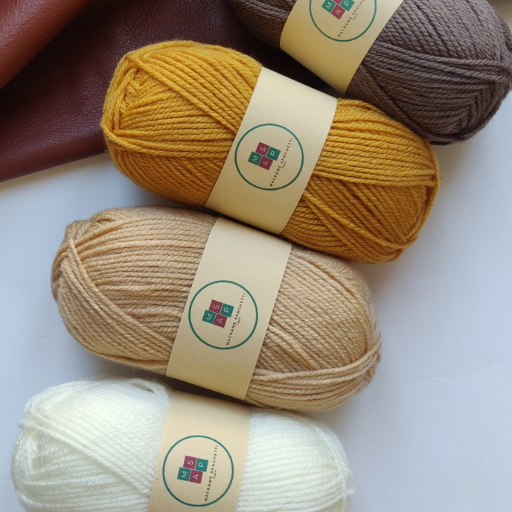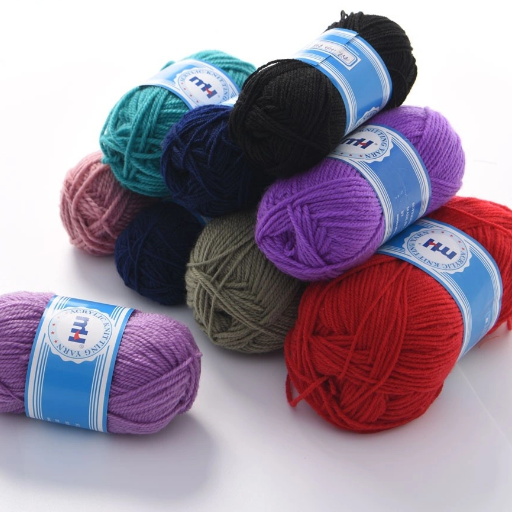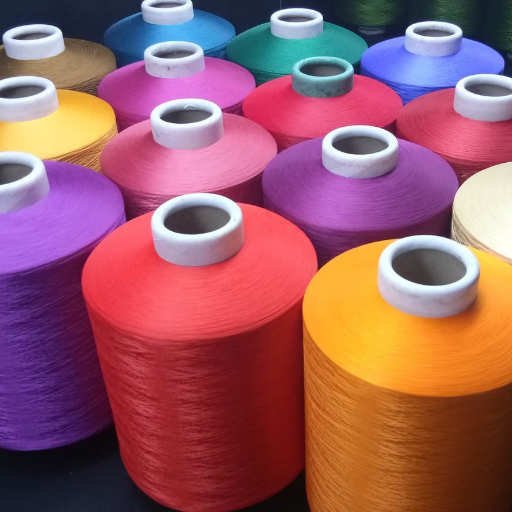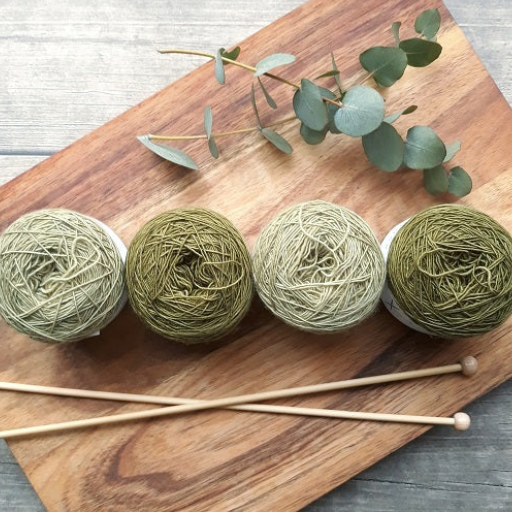Whether it’s knitting or crocheting, choosing the right yarn is one of the most vital processes because it can heavily impact the results. Out of all the available yarns, acrylic and cotton seem to be the most popular ones. From my knowledge, each of the two contains unique properties that can make them favorable or unfavorable depending on the type of work being done. This blog post will analyze both types of yarn while taking into consideration the factors of strength and longevity, texture, cost, project type competition, and care needed. By the end of my article, I hope to provide you enough insight that will allow you to choose the perfect yarn for your creative ideas without jeopardizing practicality.
What are the main differences between acrylic and cotton yarn?

Synthetic acrylic yarn is a polymer based fiber, while natural cotton yarn is made of cotton fiber. Their properties and uses reveal the differences between them. As a type of synthetic fiber, acrylic yarn is lightweight, long-lasting and inexpensive. Because it is durable and easy to care for it can be machine washed and is resistant to shrinking. These properties make it viable for relatively carefree clothing and cheaper projects. However, compared to natural fibers, it may be less soft and not as breathable. Cotton yarn is the better alternative in the acrylic vs cotton debate as it is soft, breathable, and highly absorbent which makes it perfect for sensitive skin. Acrylic yarn wins in terms of environmental impact as it is more eco-friendly. Cotton yarn is stretchable and can shrink when not handled properly. Air drying is often required to prevent damage, making it more expensive and difficult to maintain.
How do acrylic and cotton yarns differ in texture and feel?
Yarn made of acrylic has a smooth, synthetic touch to it and some brands have softer options that feel slightly less coarse, but for the most part, it feels like plastic. It has more elasticity and stretch in comparison to a cotton yarn which in contrast has a soft, gentle and natural fiber that is tender on the skin. Cotton gets softer the more it is washed. While acrylic tends to feel warmer at times due to the synthetic fibers it is made of, cotton is cool and breathable making it more desirable for sensitive skin or hot weather.
Which yarn is more durable: acrylic or cotton?
Plastic and synthetic fibers do make acrylic yarn feel warmer than cotton, but when assessing durability, cotton is much more resilient. Cotton’s fibers are more resistant to moisture, UV exposure, and abrasions alongside stretching which makes acrylic yarn more prone to damage over time. Due to being made with natural materials, cotton yarn is gentler to tear due to repeated washes, washes-done in sunlight, and overall, exposure to sunlight. Alongside that, cotton tends to weaken when wet and is more likely to shrink. Because of these reasons, projects that require these materials, need to ensure the materials last long if they want to use acrylic.
Are there differences in washability between acrylic and cotton yarns?
Indeed, there are differences in acrylic and cotton yarns with regards to their washability. It is well known that acrylic yarn is low-maintenance because it does not shrink, and can be machine washed and dried without damage. In contrast, some cotton yarns require more precise care. While many types of cotton yarn are machine washable, there are strict stipulations that if not followed will lead to the yarn being rendered unshrinkable, unwrinkled, and out of shape. Also, due to cotton’s absorbency, dry time becomes extended in comparison to acrylic. This means that cotton yarns are considered more difficult than yarns such as acrylic that can withstand rough handling.
What are the best uses for acrylic yarn?

For crochet enthusiasts and beginners alike, proprietary hobby polymer fibers such as acrylic yarn are the best possibilities for lightweight items such as socks, sweaters, hats, or even self-made presents like throw pillows because mixtures formed with this material are machine-washable. This property, combined with the vast variety of colors and textures available, also provides options for regard items such as sculptured wall hangings, blankets, or even pillows, thereby enabling including creativity into personalization and self-expression. More importantly, it provides ease for learners which makes it a preferred choice.
Which projects are ideal for acrylic yarn?
Due to its natural cotton fabric properties, Cotton yarn offers a range distinct advantages. Most importantly, it is recommended for making delicate clothes in warm weather because it is highly breathable and absorbent. It has a smooth surface which allows for clear definition of stitches so even very delicate designs of the advanced level would not be obscured. Furthermore, cotton yarns are strong and durable which results in long-lasting projects. Being hypoallergenic, it is also recommended for users with delicate skin. As it is convenient to maintain and frequently machine washed, it is versatile for a number of creations.
How does acrylic yarn perform in sweaters and garments?
The acrylic yarn keeps its form while being used in garments either as a sweater or a dress due to their lightweight and strong nature. It is resistant to fading and pilling, making it ideal for retention of looks over time. Its thermal insulation also makes it an able contender for colder clothing. It can lack breathability when compared to cotton or wool which could be a discomforting factor when exposed to warmer conditions. The material can be washed in a machine which adds to its practicality for wear, but should not be subjected to excessive heat as that might result in damage to the fibers.
Is acrylic yarn suitable for beginners?
Yes, Acrylic yarn is suitable for beginners because of its low price and easy availability. Its wide range of color and weights further make it easier for novices to express themselves. The smoothness of the yarn along with its durability allows beginners to freely practice stitches and complete Acrylic yarn does have some drawbacks for novices. Its lack of natural elasticity can lead to some complications with fraying ends of the yarn.
What are the advantages of using cotton yarn?

The properties of durability, breathability, and maintenance recommend cotton yarn as the most appropriate option for crochet projects. It does very well in the creation of garments such as summer clothes, dishcloths, haul bags, as well as home decor items, needing the yarn’s strength and ability to maintain shape. Its hypoallergenic nature also makes it perfect for baby blankets and other items for sensitive skin. Its moisture-wicking ability makes cotton yarn most useful in warm-weather projects. Moreover, the fabric’s machine-washable nature also makes it easy to maintain regularly used or gift items. Overall, cotton yarn is best suited for functional yet delicate robust crochet items.
How does pure cotton yarn behave in different seasons?
Due to the composition of natural fibers, pure cotton yarn has differing characteristics across seasons. During the summer, the moisture-absorbing and breathable properties of cotton yarn make it perfect for use since it assists in experiencing relief and regulating body temperature. It can be used for layering pieces during the winter season too, albeit offering toes the inestimably small (compared to wool) insulating qualities. It does, however, stand the test for sandwiches of other fibers for warmth. Regardless of the season, the yarns’ endurance and ability to keep its texture are a constant making it adaptable for an array of works.
What types of items are best made with cotton yarn?
Lightweight summer tops, shawls, and even baby clothes are made from fabrics that need breathability, softness, and superb moisture wicking together with a cooling effect, which is best achieved with cotton yarn. Dish towels and cloths, as well as market bags, are household items that need to withstand frequent use, and thus require durable materials, which enhances the versatility of cotton yarn. Amigurumi, sculptural and decorative accessories, as well as tote bags and cushion covers made with cotton yarn are ideal since they maintain their shape beautifully. For a variety of applications, the comfort and softness that cotton yarn provides makes it the best choice.
How do acrylic and cotton yarns compare in terms of care and maintenance?

A distinctive benefit compared to caring for yarn cotton is the ease of taking care of acrylic yarn. Its maintenance is simplest, being machine washable, instantaneous drying, and non-shrinking. Cotton yarn, being machine washable, requires more care to prevent shrinking and losing shape, especially in hot wash or dry cycles. But, awaiting high-temperature steaming, cotton can be useful for some projects. So, acrylics are better for everyday use and care, while cotton is more demanding, yet offers greater durability and natural fiber composition.
Which yarn is easier to care for: acrylic or cotton?
Washing cotton yarn can prove more difficult because of how sensitive it is to heat. Accompanying this, acrylic can be easily cleaned as it does not shrink, lose form, or quality with washing. Additionally, steam washing cotton is possible; however, the water and drying appliances are problematic due to the hyper sensitive nature of the fabric. The use of acrylic does not demand any form of effort when cleaning, therefore, making it the better more sensible choice for everyday tasks. While some may argue that cotton is more demanding when it comes to effort, as a natural fiber, its breathability and durability do serve a greater function. Like all the rest, the ultimatum will rely on how much attention one is willing to devote along with each specific instruction to follow for the project.
How do acrylic and cotton yarns handle wear and tear?
Due to cotton’s vulnerability to moisture and stress, it is strong and breathable, making it ideal for projects that undergo less stress. Acrylic yarn is far more suited for projects dealing with extreme friction, like children’s clothing, or require frequent washing, as it does not wrinkle easily due to wear and tear. Its synthetic fibers also do not degrade with regular use; unlike cotton, which frays and stretches, but does retain some construction durability.
Does one yarn type pill more than the other?
Hypothetically, if a cotton yarn and an acrylic yarn were to be placed side by side in a comparison on who is easier to pill, we would crown acrylic the winner. Piling, a yarn’s tendency to break and tangle on itself, is much easier for an acrylic yarn to do because its synthetic composition makes it much more unstable. Although natural, cotton’s tighter structure makes it more resistant to pilling, so the less a cotton yarn is allows to do so, the more durable it becomes. Factors like the yarn’s quality, how the finished product is used, and its overall care heavily influence the chances of pilling.
What factors should you consider when choosing between acrylic and cotton yarn?

When selecting between acrylic and cotton yarn, take note of the following:
1. The Acrylic yarn is warm, lightweight, and best suited for use in blankets, outdoor sweaters, or any knitwear clothing. In contrast, cotton yarn is suitable for garments as well as durable home goods like dishwashing clothes or summer wear.
2. Skin sensitivity necessitates the use of softer and more comfortable cotton clothing. Regarding clothing fabrics, they encompass a broad range of materials, acrylic included, which can be high end and therefore softer yet less supple and rigid.
3. Washing acrylic yarn is less complicated and it dries faster, however, cotton may shrink or lose its original shape if not given proper washing techniques.
4. Acrylic yarn is relatively cheaper and easily accessible. In addition, cotton yarn in its premium quality is quite costly, but it yields a great return on investment.
5. Opting for cotton may seem like a good choice, as they are made from natural fibers, hence the material is more environmentally friendly than its counterpart, acrylic which is a synthetic fiber derived from petroleum.
6. Knitting materials made from cotton exemplify high durability standards as it doesn’t pill easily alongside maintaining its form. In contrast, materials made from acrylic weaken over time and lose their overall sturdiness faster.
How do project requirements influence your choice between acrylic and cotton?
Your abstract shall not exceed 150 words, thus explaining the differences between acrylic and cotton yarn will serve best in one singular sentence each, letting the reader uncover the reasoning on their own. Each choice meets a requirement: softness, elasticity, abundant colors, eco-friendly materials, budget-friendly, ease of care, breathability, softness, and lack of bulk—covering every aspect from aesthetics to function. Irrespective of personal preferences, motives guided by sensitivity to environment or texture stand direct, with the final product being breathable soft dish clothes or summer wear alongside infamously fluffy cotton.
What role does personal preference play in selecting acrylic or cotton yarn?
Appreciating the exceptional feel alongside the sheer level of vertical and horizontal textures yields the result: subjective imperialized satisfaction toward the acrylic yarn emerges. Ultimately, personal preference single-handedly plays a large and crucial role in one’s journey with respectfully understanding their ethical values and harsh realities surrounding the vivid spectrum of yarn colors available.
How do cost and availability factor into the decision?
Both acrylic and cotton yarn have their benefits based on cost and availability. Since acrylic is synthetic and mass produced, it is usually more affordable and accessible, making it a popular choice for large scale projects. On the other hand, cotton yarn is more eco-friendly and durable even if it costs more because of its natural fibers. Cotton yarns may also have lower availability in certain regions or times, but the most economically friendly option is based on cost and demand.
Can you mix acrylic and cotton yarns in the same project?

As with many mediums, blending acrylic and cotton yarns in a single project is achievable, albeit awareness of its specifics is paramount. In this case, the most obvious distinction would be the texture, stretching capability, or even the care level required for the two fibers. For instance, cotton yarn is completely devoid of stretch and elasticity, while absorbing moisture, on the other hand, is more stretchable and moisture resistant. Furthermore, all yarns used must be of the same weight and gauge, otherwise, the uniformity and coherence of the fabric will be lost. Care instructions need to be adhered to as well since the same steps may result in different responses from each material, especially in the case of cotton and acrylic. If blended properly, these yarns can produce something functional and special.
What are the benefits of combining acrylic and cotton yarns?
A blend of both fibers can achieve reliable and convenient results. Cotton and acrylic yarns can now be blended together to bring out the best features of each fiber unlike wool which has its limitations. With the right shape and finish, items created will be lightweight yet strong; this makes the items adaptable to being worn or used as décor around the home. Not to forget the ease of care needed due to acrylic’s resiliency and cotton’s absorbent nature. All of these factors open the door to projects that look appealing, but are practical to use.
Which projects work well with a mix of acrylic and cotton?
Acrylic and cotton blended together works well for projects which require comfort as well as durability. Due to its softness and breathability, it is ideal for summer tops, cardigans, and even baby clothes. Dishcloths, placemats, or throw blankets are some of the home décor items made with the blended material because it is strong yet soft and absorbent as cotton. It is also crafted into warm-weather accessories like hats or market bags because of their flexibility and structure. This yarn’s versatility makes it the best option for easy-care, texture, and performance balanced projects.
References
Frequently Asked Questions (FAQ)
Q: Is acrylic yarn scratchy compared to cotton yarn?
A: Generally, acrylic yarn is not scratchy and is often softer than many cotton yarns. However, the texture can vary by brand and quality, so it’s important to sample different types of yarn before choosing the right yarn for your crochet project.
Q: How does the durability of acrylic vs cotton yarn compare?
A: Acrylic yarn is generally more durable and resistant to wear than cotton yarn, making it a great option for items that will see heavy use. Cotton, while strong, can wear out more quickly, especially when used in crochet projects that require a lot of stretching.
Q: Which type of yarn is better for baby items: acrylic or cotton?
A: Both yarns have their pros and cons for baby items. Acrylic yarn is easy to wash and care for, while cotton yarn is breathable and hypoallergenic. It’s best to choose a soft, non-scratchy yarn that is safe for babies, so consider your specific project requirements when choosing the right yarn for your crochet.
Q: Can I use acrylic yarn for projects traditionally made with cotton yarn?
A: Aluminum wouldn’t restrict you. You can opt for acrylic yarn in projects customarily done with cotton, including dishcloths and summer wear. Just remember that the outcome, as far as texture and drape, may be different. For beginners new to crocheting, acrylic yarn is also easier to handle.
Q: Is cotton yarn better for warm-weather projects than acrylic yarn?
A: Yes, cotton yarn is often preferred for warm-weather projects due to its breathability and lightweight nature. Cotton vs acrylic for summer items like tops or shawls leans towards cotton, as it keeps you cooler and is less stifling.
Q: How do I choose the right yarn for my crochet project?
A: Choosing the right yarn for your crochet project involves considering the type of item you are making, the desired texture, and the care instructions. Consider whether you want a soft, drapey finish (cotton) or a more robust, easy-care option (acrylic) based on your project’s needs.
Q: Are there any yarns that combine acrylic and cotton fibers?
A: Yes, there are blended yarns that combine acrylic and cotton fibers, offering the benefits of both materials. These blends often provide the softness of cotton and the durability of acrylic, making them a versatile choice for various crochet projects.
Q: What are some common crochet projects that use acrylic yarn?
A: Common crochet projects that use acrylic yarn include granny squares, blankets, hats, and scarves. Acrylic yarn is easy to work with and comes in a wide variety of colors, making it a popular choice among crocheters for many different types of yarn projects.








